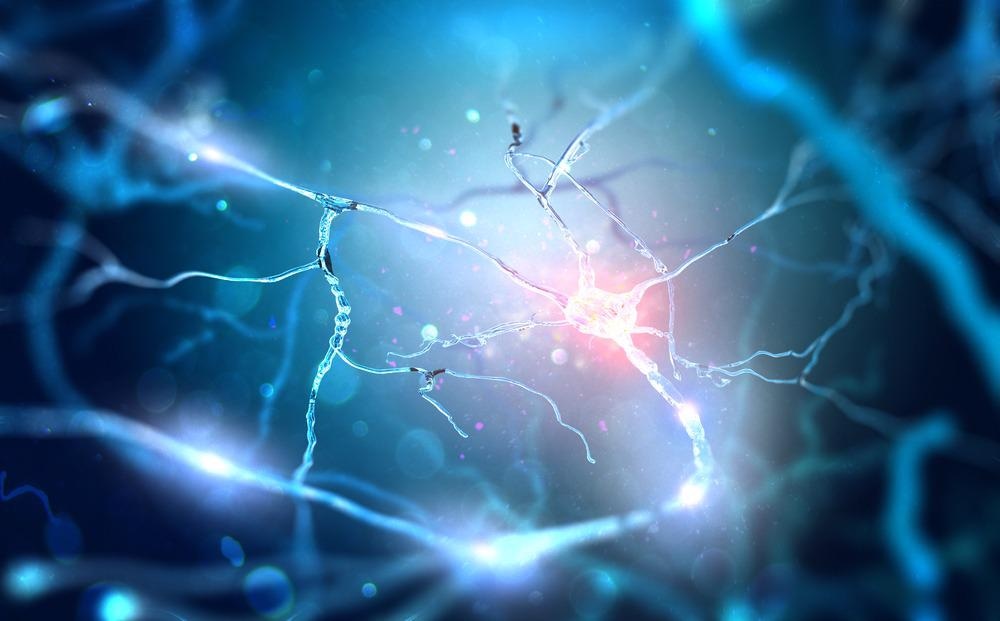Expansion microscopy allows researchers to map the organization of molecules and cells present in neural circuits. These enable the construction of a blueprint that is critical in determining how complex brain functions are produced. This has been aided by the development of expansion microscopy.

Image Credit: Andrii Vodolazhskyi/Shutterstock.com
It is a very recent technology, that continues to emerge, that overcomes the limits of optical super-resolution techniques by physically expanding tissue samples with a polymer that swells under the influence of water.
Adding water to a monomer called acrylate causes polymerization, which subsequently results in swelling. This swelling pushes cellular components apart as it continues to expand. Early attempts to use this form of microscopy resulted in uneven swelling or cracking of cells. However the addition of enzymes to soften tissues before polymerization enabled researchers to expand tissue samples to 4.5 times their original size.
Iterations of this technique employ a hydrogel which maintains a more uniform configuration than typically used in conventional expansion microscopy
How Does Expansion Microscopy Work?
Microscopy has enabled the discovery of several biological phenomena by using optics to magnify images of structures in fixed cells and tissues. Physical magnification of the specimen itself is also a possibility and can be achieved by synthesizing a swellable polyelectrolyte gel network directly in this specimen, followed by sample dialysis using water.
Gel structures can be expanded isotropically by applying gel anchorable to target biomolecules before the polymerization reaction and subjecting this to proteolytic digestion after polymerization. In this sense, individual features of the cell move away from one another while remaining in the same relative position.
Consequently, this method overcomes the optical diffraction limit that occurs as a result of labels being spaced closer than the optical diffraction limit, enabling separate molecules to be expanded to distances large enough to be resolved with conventional microscopes. Therefore, this process enables scalable super-resolution microscopy with diffraction-limited microscopes.
The Invention of Expansion Microscopy
The seminal example of expansion microscopy in action was in the context of transcriptomics, where a team, led by neuroscientist Edward Boyden at the Massachusetts Institute of Technology demonstrate expansion microscopy at ~70-nanometer lateral resolution and performed superresolution imaging of the mouse hippocampus at ~107 cubic micrometers with a conventional confocal microscope.
Expansion Microscopy in Action: Nanoscale Resolution Maps of RNAs
The team later used the concept of expansion microscopy to locate specific RNAs in tissues. To achieve this, the team applied expansion sequencing to a mouse brain which produced a readout of thousands of genes. This was comprised of expanding a targeted section of mouse brain tissue followed by in situ RNA sequencing.
Targeted expansion sequencing subsequently produced nanoscale resolution maps of RNAs present in dendrite sand spines in the neurons of the mouse hippocampus. This enabled patterns to be determined across several different types of cells across the mouse visual cortex and enable elucidation of the organization and position-dependant states of both immune and tumor cells in a human metastatic breast cancer biopsy.
Expansion Microscopy in Action: Visualising Protein Machinery at Axon Terminals
In another study, a team was able to determine the structure and events occurring at synapses, which are traditionally elusive structures to study. Previously, indirect methods such as silver staining were employed to visualize the process of protein formation at synapses. By using expansion microscopy, the team was able to demonstrate the localization of messenger RNA and protein synthesis in the synapses of neuronal dendrites. Expansion microscopy was used to resolve both the pre-and postsynaptic compartments in rodent neurons.
These synaptosomes (isolated synaptic terminal from a neuron), word fluorescent labeled and subsequently sequenced to reveal the presence of hundreds of mRNA species, with > 30% of presynaptic terminals exhibiting a signal, indicating ongoing protein synthesis. Overall, the team was able to demonstrate that presynaptic terminals are capable of translation, and the differential recruitment of local protein synthesis results in phoenix types unique to compartments within the neuron, and it is these that form the basis of different forms of plasticity.
Expansion Microscopy in Action: Resolving Bacterial Cells of Different Species
The imaging of diverse microbial communities is a challenge because several species have similar morphologies. This was applied in the context of in vivo imaging of a model gut microbiota, where the interaction of Salmonella with human gut cells was determined.
By using expansion microscopy, a team was able to determine that expression patterns depend on the structural and mechanical properties of the cell wall; enabling the team to measure the strength of thousands of cell walls. Consequently, the team was able to sensitively detect damage to the cell envelope caused by antibiotics and on earth previously unseen cell-to-cell phenotypic heterogeneity present in pathogenic bacteria.
The team was also able to resolve bacterial cells of different species in distinct physiological states.
Expansion microscopy is evolutionary in the context of microscopy imaging as it presents an inexpensive imaging methodology that is compatible with ordinary light microscopes to image at the nanometer scale. Central to this methodology is the application of a hydrogel that is capable of maintaining uniform configuration.
Sources:
- Hafner AS, Donlin-Asp PG, Leitch B, et al. (2019) Local protein synthesis is a ubiquitous feature of neuronal pre-and postsynaptic compartments. Science. doi: 10.1126/science.aau3644. PMID: 31097639.
- Lim Y, Shiver AL, Khariton M, et al. (2019) Mechanically resolved to image of bacteria using expansion microscopy. PLoS Biol. 2019 Oct 17;17(10):e3000268. doi: 10.1371/journal.pbio.3000268.
- Chen F, Tillberg PW, Boyden ES. (2015) Optical imaging. Expansion microscopy. Science. doi: 10.1126/science.1260088.
- Chen F, Tillberg PW, Boyden ES (2015) Optical imaging. Expansion microscopy. Science.. doi: 10.1126/science.1260088.
- Alon S, Goodwin DR, Sinha A, et al. (2021) Expansion sequencing: Spatially precise in situ transcriptomics in intact biological systems. Science. doi: 10.1126/science.aax2656.
Further Reading
Last Updated: Mar 22, 2022